Syntheses,Structures and Magnetic Properties of Manganese Phosphonates
LIU BeiBAO Song-Song REN Min CAI Zhong-Sheng LIU Jing-CuiZHENG Li-Min
(State Key Laboratory of Coordination Chemistry,School of Chemistry and Chemical Engineering,Nanjing University,Nanjing 210023,China)
Abstract:Reactions of(4-carboxynaphthalen-1-yl)phosphonic acid (4-cnappH3)with manganese chloride under solvo/hydrothermal conditions resulted in four new coordination polymers,formulated as Mn(4-cnappH2)2(1),Mn(4-cnappH2)2(H2O)2(2),α-Mn(4-cnappH)(H2O)(3)and β-Mn(4-cnappH)(H2O)(4).Compound 1 shows a 3D framework structure,where chains made up of corner-sharing {MnO6}octahedra and {PO3C}tetrahedra are cross-linked by the organic groups of the phosphonate ligands.Compounds 2~4 exhibit 2D layered structures with interlayer hydrogen bonds through the pendent carboxylic acid groups.However,the layer topologies are different in the three cases.In 2,the {MnO6}octahedra and {PO3C}tetrahedra are corner-shared with each other alternatively,forming an inorganic layer containing rectangular-shaped 12-membered rings.In 3,edge-sharing dimers of{Mn2O2}are connected by {PO3C}tetrahedra through corner-sharing,forming an inorganic layer containing 4-membered rings.In 4,chains of corner-sharing{MnO5}are connected by{PO3C}tetrahedra into an inorganic layer containing 3-and 4-membered rings.Magnetic studies reveal that antiferromagnetic interactions are dominant in all four compounds.CCDC:1990441,1;1990442,2;1990443,3;1990444,4.
Keywords:phosphonate;manganese;coordination polymer;magnetic
Metal-organic systems have provided tremendous possibilities in building up new molecular materials with potential applications in various areas such as sorption and separation,catalysis,sensors and other functional materials[1-3].As an important class of metalorganic materials,metal phosphonates possess advantages over many others in their high water and thermal stabilities due to the strong coordination capabilities of the phosphonate ligands and the presence of inorganic components (cluster,chains and layers)in the molecular composite[4].During the past two decades,great efforts have been devoted to the syntheses of metal phosphonates with new architectures and interesting physical or chemical functions[5-8].Among them,metal phosphonates containing carboxylate groups are of particular interest as they provide additional coordination sites for metal ions[4].For example,by using 2/3/4-carboxyphenylphosphonic acid (2/3/4-cppH3)asreaction precursor,a series of metal phosphonate compounds with 1D,2D and 3D structures have been reported[9],and some of them show interesting magnetic[10],dielectric[11]and chiroptical properties[12].The (4-carboxynaphthalen-1-yl)phosphonic acid (4-cnappH3)is analogues to 4-cppH3except with an expanded aromatic moiety.However,only four metal phosphonates based on this ligand have been described,including a cobalt compound with 3D framework structure showing enantioenrichment[13]and three copper compounds with layered structures[14].To explore new aromatic phosphonate-carboxylate materials,herein we report four new manganese phosphonates based on 4-cnappH3,formulated as Mn(4-cnappH2)2(1),Mn(4-cnappH2)2(H2O)2(2),α-Mn(4-cnappH)(H2O)(3) and β-Mn(4-cnappH)(H2O)(4).Compound 1 shows a 3D framework structure,whereas 2~4 exhibit 2D layered structures but with different layer topologies.The magnetic properties of all four compounds are also investigated.
1 Experimental
1.1 Materials and characterization
The (4-carboxynaphthalen-1-yl)phosphonic acid(4-cnappH3) was synthesized according to the literature method[13,15].All the other starting materials were obtained from commercial sources without further purification.Elemental analysis for C,H,N were performed on a Perkin-Elmer 240C elemental analyzer.The infrared spectra were recorded on a Bruker Tensor 27 spectrometer with pressed KBr pellets in the 400~4 000 cm-1region.Powder X-ray diffraction patterns(PXRD)were recorded in 2θ range of 3°~50°on a Bruker D8 ADVANCE X-ray powder diffractometer(40 kV and 40 mA)using Cu Kα radiation(λ=0.154 18 nm)at room temperature.The magnetic susceptibility data were obtained using polycrystalline samples by a Quantum Design MPMS-XL7 SQUID magnetometer or MPMS SQUID VSM.The diamagnetic contribution of the sample itself was estimated from Pascal′s constant[16].
1.2 Syntheses of manganese phosphonates
1.2.1 Synthesis of Mn(4-cnappH2)2(1)
A mixture of MnCl2·4H2O(0.029 9 g,0.15 mmol)and 4-cnappH3(0.025 3 g,0.10 mmol)in 10 mL of H2O/methanol(2∶3,V/V),adjusted to pH=3.05 with 0.5 mol·L-1NaOH and 0.5 mol·L-1HCl,was kept in a Teflon-lined autoclave at 100℃for 3 d.After cooling to room temperature,light yellow block-like polycrystalline materials of 1 were obtained as a pure phase,confirmed by the powder XRD measurements(Fig.S1).Yield:40.8%(based on 4-cnappH3).Elemental analysis found(Calcd.)for C22H16O10P2Mn(%):C,48.01(47.41);H,3.01(2.90).IR(KBr,cm-1):3 425(b,m),2 902(b,m),1 678(s),1 584(w),1 513(m),1 463(w),1 421(m),1 319(m),1 302(w),1 211(m),1 153(m),1 106(vs),1 078(m),1 044(vs),1 015(vs),961(s),903(m),858(m),788(m),741(m),674(m),624(m).
1.2.2 Synthesis of Mn(4-cnappH2)2(H2O)2(2)
Compound 2 was synthesized following a similar procedure to compound 1 except that the pH value of the reaction mixture was 3.80.Colorless plate-like crystals were obtained as a pure phase,confirmed by the powder XRD measurements(Fig.S1).Yield:34.4%(based on 4-cnappH3).Elemental analysis found(Calcd.)for C22H20O12P2Mn2(%):C,44.95(44.54);H,3.43(3.40).IR(KBr,cm-1):3 628(m),3 576(m),3 414(m),3 088(b,m),1 709(s),1 652(m),1 633(m),1 578(w),1 515(m),1 459(m),1 404(w),1 279(m),1 249(m),1 187(s),1 167(m),1 121(s),1 048(vs),1 007(m),944(m),904(m),858(w),797(w),774(s),675(m).
1.2.3 Synthesis of α-Mn(4-cnappH)(H2O)(3)
Compound 3 was synthesized following a similar procedure to compound 1 except that the solvent was pure water(6 mL)and the pH value of the reaction mixture was 3.60.Colorless plate-like crystals were obtained as a pure phase,confirmed by the powder XRD measurements(Fig.S1).Yield:34.4%(based on 4-cnappH3).Elemental analysis found (Calcd.)for C11H9O6PMn(%):C,40.56(40.89);H,3.01(2.79).IR(KBr,cm-1):3 332(b,m),3 055(b,m),2 361(w),1 694(s),1 580(m),1 515(m),1 458(w),1 353(w),1 309(m),1 284(m),1 257(m),1 203(m),1 153(w),1 126(m),1 081(vs),1 034(vs),1 017(vs),984(s),927(m),855(w),794(w),773(s),677(m),614(m).
1.2.4 Synthesis of β-Mn(4-cnappH)(H2O)(4)
Compound 4 was synthesized following a similar procedure to 3 except that the pH value of the reaction mixture was 4.10 and the reaction temperature was 140℃.Colorless flake-like crystals were obtained as a pure phase,confirmed by the powder XRD measurements(Fig.S1).Yield:50.1% (based on 4-cnappH3).Elemental analysis found(Calcd.)for C11H9O6PMn(%):C,40.66(40.89);H,2.93(2.79).IR(KBr,cm-1):3 334(b,m),2 361(vs),2 341(vs),1 697(s),1 618(m),1 581(w),1 516(m),1 459(w),1 405(m),1 285(m),1 260(m),1 205(w),1 154(w),1 124(m),1 069(s),1 025(s),1 003(s),979(vs),860(m),794(w),773(s),679(s),619(m).
1.3 Structure determination
Single crystals of dimensions 0.3 mm×0.1 mm×0.05 mm for 1,0.3 mm×0.02 mm×0.05 mm for 2,0.2 mm×0.15 mm×0.05 mm for 3,and 0.3 mm×0.1 mm×0.1 mm for 4 were used for structural determination on a Bruker APEX DUO diffractometer(Mo Kα,λ=0.071 073 nm)at 123 K (for 1 and 2)or Bruker APEX Ⅱ diffractometer(Mo Kα,λ=0.071 073 nm)at 296 K(for 3 and 4).A total of 8 952,18 518,4 613 and 15 806 diffraction points were collected for compounds 1~4 in the range of 1.8°< θ< 26.0°,2.1°< θ< 26.0°,3.5°< θ< 27.0°and 2.2°< θ< 28.3°,respectively,in which the independent diffraction points were 2 320(1:Rint=0.046),4 591 (2:Rint=0.057),2 385 (3:Rint=0.032)and 2 761(4:Rint=0.082),respectively.The observed diffraction points(I>2.0σ(I))were 1 902,3 788,2 125 and 1 969 for 1~4,respectively.The collected data were integrated by using the Siemens SAINT program[17],with the intensities corrected for the Lorentz factor, polarization, air absorption, and absorption due to variation in the path length through the detector face plate.Absorption corrections were applied.The structures were solved by direct methods and refined on F2by full-matrix least-squares by using SHELXTL[18].All the non-hydrogen atoms were located from the Fourier maps and were refined anisotropically.The organic groups in 3 and 4 are disordered over two sites.The disordered atoms were refined anisotropically.All hydrogen atoms bound to carbon were refined isotropically in the riding mode;hydrogen atoms bound to phosphonate and carboxylate oxygen were calculated on idealized positions by taking into account C-O and P-O bond lengths;hydrogen atoms of water molecules were detected in the experimental electron density map and then refined isotropically with reasonable restriction of O-H bond distances and H-O-H angles.The crystallographic data of the compounds are listed in Table 1.Selected bond lengths and angles are given in Table 2.
CCDC:1990441,1;1990442,2;1990443,3;1990444,4.
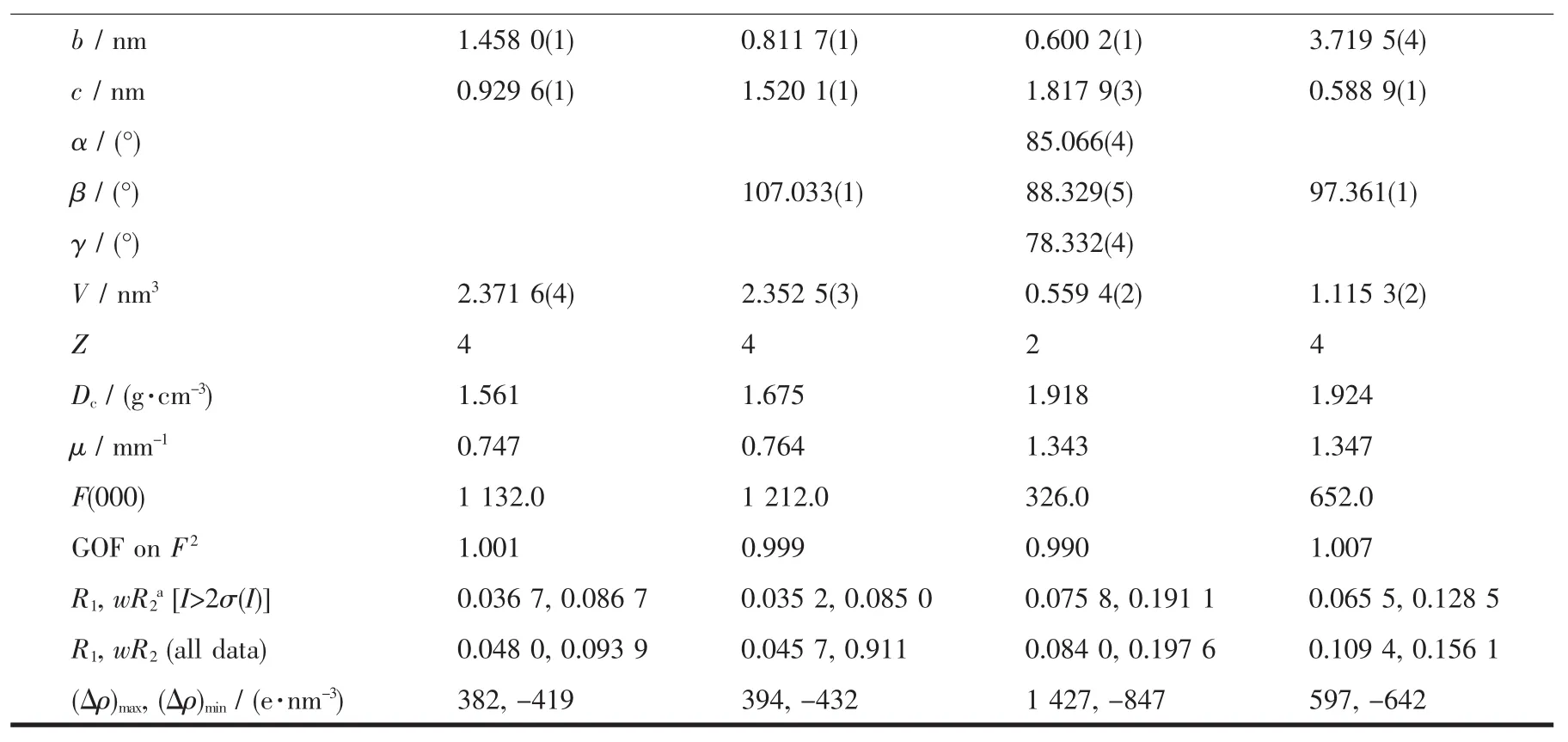
Continued Table 1

Table 2 Selected bond lengths(nm)and bond angles(°)for compounds 1~4

Continued Table 2
2 Results and discussion
2.1 Crystal structures of 1 and 2
Compounds 1 and 2 were synthesized under similar solvothermal reaction conditions in water/methanol solution except the pH value of the reaction mixture(3.05 for 1,and 3.80 for 2,Scheme 1).Although the chemical composition of 2 is different from that of 1 by two additional water molecules,their structures are completely different.
Single crystal structural determination reveals that 1 crystalizes in orthorhombic system space group Pbcn.The asymmetric unit consists of 0.5 Mn atom and one 4-cnappH2-ligand.The Mn atom has an octahedral geometry with the six sites occupied by four phosphonate oxygen and two carboxylate oxygen atoms from six equivalent 4-cnappH2-ligands(Fig.1a and S4a,Table 2).The Mn-O bond lengths(0.215 0(2)~0.220 0(2)nm)are comparable to those in the other manganese phosphonate compounds[19].
Each 4-cnappH2-acts as a tri-dentate bridging ligand,binding to three equivalent Mn atoms via two phosphonate oxygen (O2,O3)and one carboxylate oxygen (O4)atoms(Scheme 2a).The remaining one phosphonate oxygen (O3)and one carboxylate oxygen(O5)atoms are protonated.As a result,the equivalent Mn atoms are doubly bridged by the O-P-O units forming infinite chains running along the c-axis with extensive intrachain hydrogen bond interactions(Fig.1a).The neighboring chains are cross-linked by the organic groups of 4-cnappH2-,leading to a threedimensional framework structure(Fig.1b).The shortest Mn…Mn distances are 0.528 4 nm within the chain and 1.138 8 nm between the chains.
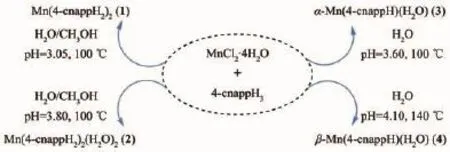
Scheme 1 Synthetic routes of compounds 1~4
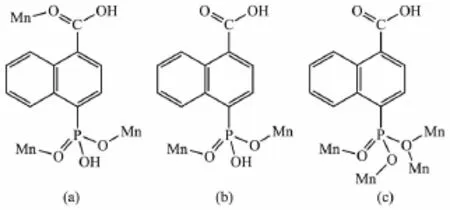
Scheme 2 Coordination modes of 4-cnappH3in compounds 1(a),2(b),3 and 4(c)
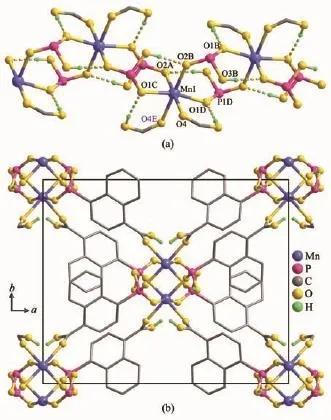
Fig.1 (a)Single chain structure of compound 1;(b)Packing diagram of structure 1
Compound 2 crystallizes in monoclinic space group P21/c.The asymmetric unit contains one Mn,two 4-cnappH2-and two water molecules.The Mn atom is again octahedrally coordinated but by four phosphonate oxygen atoms(O1,O2A,O4,O5B)and two water molecules(O1W,O2W)(Mn-O 0.209 7(1)~0.223 0(1)nm,∠O-Mn-O=84.5(1)°~173.8(1)°,Fig.2a and S4b,Table 2),unlike that in 1 where the carboxylate oxygen atoms occupy two sites.In addition,each 4-cnappH2-ligand binds to two instead of three equivalent Mn atoms using two of its three phosphonate oxygen donors,leaving both carboxylate oxygen atoms pendant (Scheme 2b).The{MnO6}octahedra and {PO3C}tetrahedra are corner-shared with each other alternatively,forming an inorganic layer containing rectangular-shaped 12-membered rings of Mn6P6(Fig.2a).The Mn…Mn distances within the layer are 0.519 2 and 0.511 6 nm over O-P1-O and O-P2-O units,respectively.Extensive hydrogen bond interactions are present within the layer among the phosphonate oxygen atoms and coordination water molecules.The layers are stacked along the a-axis with the 4-carboxynaphthalen-1-yl groups filling in the interlayer space (Fig.2b).Hydrogen bond interactions are found between the protonated carboxylic groups of the adjacent layers(O7…O9A 0.266 8(135)nm,O10…O9A 0.269 5(127)nm,Symmetry code:A:1+x,1+y,z).The interlayer distance is 1.905 8 nm.

Fig.2(a)Inorganic layer in structure 2;(b)Packing diagram of structure 2
2.2 Crystal structures of 3 and 4
Compounds 3 and 4 were synthesized under hydrothermal conditions at different temperatures(Scheme 1).They are isomers with the same molecular formula,but crystallize in different space groups,triclinic P1 for 3 and monoclinic P21/n for 4.In both cases,the asymmetric unit is composed of one Mn,one 4-cnppH2-and one water molecule.The Mn atoms in 3 and 4 have distorted trigonal bipyramidal geometries(Fig.S5a and S5b),unlike those in 1 and 2.For 3,three equatorial sites of{MnO5}are occupied by the phosphonate oxygen atoms(O1,O2B,O3A),and the axial positions by phosphonate oxygen atom(O2C)and one water(O1W)(Mn-O 0.206 3(6)~0.218 1(5)nm)(Fig.3a).The sum of equatorial O-Mn-O angles,ranging from 114.9°to 129.0°,is 359.5°.The axial O2C-Mn1-O1W angle is 166.1°.The{MnO5}geometry in 4 is more distorted with the equatorial O-Mn-O angles ranging from 105.8°to 144.5°and the axial OMn-O angle of 168.8°(Fig.3c).The coordination modes of the 4-cnppH2-ligands are also quite similar in 3 and 4,each serves as a tetra-dentate ligand connecting four Mn atoms using its three phosphonate oxygen donors,one of which serves as a μ3-O bridge(Scheme 2c).The carboxylate groups are protonated and not involved in coordination with metal ions.Remarkably,although both show layer structures,their layer topologies are significantly different.In 3,two equivalent{MnO5}are edge-shared with each other forming{Mn2O2}dimers(∠Mn1-O2B-Mn1C=102.1(2)°).The dimers are further connected by O-P-O linkages,forming an inorganic layer containing 4-membered rings of Mn2P2(Fig.3a).In 4,the equivalent{MnO5}are corner-shared with each other forming chains of Mn-O-Mn-O (∠Mn1-O1C-Mn1C=116.1(2)°),which are connected by the {PO3C}tetrahedra via cornersharing of{MnO5}and{PO3C}into an inorganic layer containing 3-and 4-membered rings of Mn2P and Mn2P2(Fig.3c).The different topologies result in different Mn…Mn distances within the layer.The Mn…Mn distances over the μ3-O bridge in 3 (0.336 4 nm)is shorter than that in 4(0.368 6 nm).Those over the O-P-O bridges are 0.391 7,0.414 6 and 0.471 4 nm in 3,and 0.417 8 and 0.513 4 nm in 4.The layers are stacked along the c-axis(for 3)or b-axis(for 4)with interlayer hydrogen bond interactions through the carboxylic acid groups,thus leading to 3D supramolecular frameworks(Fig.3b and 3d).
It is worth mentioning that there are only four compounds reported so far based on the same phosphonate ligand.Compound Co2(4-cnapp)(OH)(H2O)2has a 3D framework structure in which the Δ-type chains of corner-sharing Co3(μ3-OH)triangles are crosslinked by the organic groups of the phosphonate ligands.Compounds α-Cu(4-cnappH)(H2O)and α-Cu(4-cnappH)(H2O)·0.5H2O display layer structures containing 4-and 8-membered rings made up of{CuO4}planes and {PO3C}tetrahedra.In β-Cu(4-cnappH)(H2O),the layer topology is composed of edge-sharing dimers of{CuO5}square pyramids and{PO3C}linkages which is similar to that in 3.Therefore,compounds 1,2 and 4 provide new types of structures of metal phosphonates based on (4-carboxynaphthalen-1-yl)phosphonate ligand.As far as we are aware,the layer topology of 4 has not been observed in the other layered metal phosphonate materials.
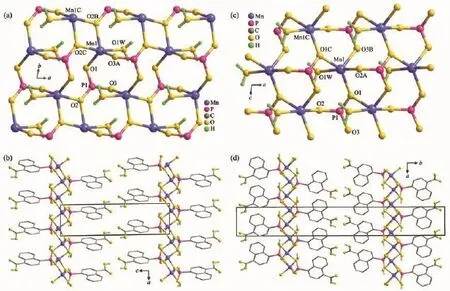
Fig.3 (a)Inorganic layer and(b)packing diagram of structure 3;(c)Inorganic layer and(d)packing diagram of structure 4
2.3 Magnetic properties
Temperature dependent magnetic susceptibilities were measured for 1~4 in a temperature range of 1.8~300 K.The observed room temperature χMT values per Mn unit were 4.43 cm3·K·mol-1for 1,5.00 cm3·K·mol-1for 2,4.40 cm3·K·mol-1for 3,and 4.26 cm3·K·mol-1for 4,which are close to the theoretical value(4.38 cm3·K·mol-1)for one Mn(Ⅱ) ion with g=2.0.Upon cooling,the χMT values decreased with decreasing temperature in all cases,indicating that dominant antiferromagnetic (AF)interactions are propagated between the Mn(Ⅱ)ions.
For 1,there exists O-P-O bridged equally spaced manganese chains,inter-connected by the organic groups.The Mn…Mn distances within the chain(0.528 4 nm)is much shorter than that between the chains(1.138 8 nm).Thus the magnetic susceptibility data can be analyzed using Fisher′s expression for a uniform chain based on Hamiltonian H=-J∑SASA+1,with the classical spins scaled to a real quantum spin of S=5/2[16],leading to parameters g=2.03,J=-0.13 cm-1(Fig.4).The negative exchange coupling constant(J)confirms the presence of weak AF interactions.This value is close to those in[NH3(CH2)4NH3][Mn(hedpH2)2](J=-0.18 cm-1)[20]and Mn{(C7H5N2)CH2N(CH2PO3H)2}(J=-0.08 cm-1)[21]which also contain manganese chains with O-P-O linkages.
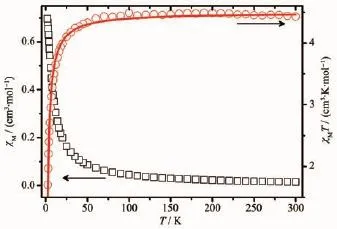
Fig.4 χMvs T(black)and χMT vs T(red)plots for 1
Compound 2 has a layer structure containing rectangular-shaped 12-membered rings in which each Mn is linked to three equivalents via O-P-O units.The Mn…Mn distances within the layer are 0.519 2 and 0.511 6 nm.It is difficult to find a suitable model to fit the susceptibility data.Hence the data were simply fitted by the Curie-Weiss law,leading to the Curie constantof4.29 cm3·K·mol-1and Weiss constant(θ)of-1.56 K(Fig.S7).The negative θ value also confirms the presence of AF interactions in 2.
For 3,the layer structure is composed of{Mn2O2}dimers inter-connected by O-P-O units.Assuming that the exchange coupling within the dimer over μ3-O(P)bridge(J)is much stronger than that over the O-P-O bridge between the dimers(zJ′),the susceptibility data can be analyzed by an isotropic dimer model for two S=5/2 spins based on the Heisenberg Hamiltonian H=-JSASB[16].The best fit gave parameters g=2.03,J=-0.82 cm-1,zJ′=0(fixed)(Fig.5).The exchange coupling constant is more negative than that for 1,in agreement with the stronger AF interaction mediated over the μ3-O(P)bridge than that over the O-P-O linkage.The J value also agrees well with those for the other manganese phosphonates containing μ3-O(P)bridged{Mn2O2}dimers[20].The magnetization measured at 2.0 K showed a slight sigmoid curve(Fig.5,Inset).The M value increased linearly with increasing field from zero to 18.8 kOe,above which it increased faster.The result is indicative of a spin flipping behavior from AF group state of the material.
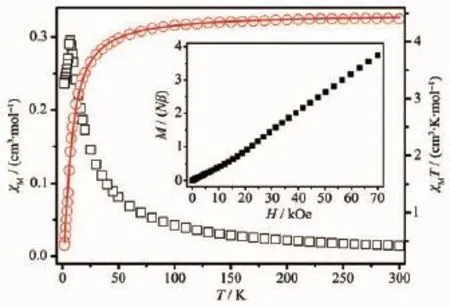
Fig.5 χM vs T(black)and χMT vs T(red)plots for 3
In the case of 4,chains of Mn-O-Mn-O are separated by the O-P-O units within the inorganic layer.Both the negative Weiss constant(-36.1 K)and the maximum appearing at 7.5 K in the χMvs T curve support the presence of AF interactions between the magnetic centers(Fig.S8a).However,an attempt to fit the susceptibility data using Fisher′s chain model could not give a reasonable result,indicating that the exchange couplings propagated through μ3-O(P)and O-P-O bridges are comparable.The magnetization curve again reveals a spin flipping behavior with the critical field of 20 kOe at 2.0 K(Fig.S8b).
3 Conclusions
We report four manganese phosphonates based on(4-carboxynaphthalen-1-yl)phosphonic acid,namely,Mn(4-cnappH2)2(1),Mn(4-cnappH2)2(H2O)2(2),α-Mn(4-cnappH)(H2O)(3)and β-Mn(4-cnappH)(H2O)(4),simply by modifying the reaction conditions such as the solvent and the pH of the reaction mixture.Compound 1 shows a 3D framework structure containing inorganic chains,whereas 2~4 exhibit 2D layered structures with different topologies of the inorganic layers.Antiferromagnetic interactions are found to be dominant in all four compounds.Spin flipping behavior is observed in compounds 3 and 4.
Supporting information is available at http://www.wjhxxb.cn
- 無機化學學報的其它文章
- 《無機化學學報》投稿須知(NOTICE TO AUTHORS)
- An N-Alkylated 2-(5-Bromo-4-methylthiophen-2-yl)-imidazo[4,5-f]-[1,10]-phenanthroline Rhenium(Ⅰ)Tricarbonyl Compound Showing Aggregation-Induced Emission Enhancement
- Two Zn(Ⅱ) and Cd(Ⅱ) Metal-Organic Frameworks with Mixed Ligands:Synthesis,Structure,Sorption and Luminescent Properties
- Syntheses and Crystal Structures of Two Copper Complexes Based on Quinolyl and Pyridyl Substituted Triaryltriazoles
- Plasma-Assisted Fabrication of Ferroelectric Flakes with Single-Unit-Cell Thickness and Characterization of Ferroelectricity
- Formation of Zirconium Chloride Guanidinate Complexes from the Reaction of their Amide Analog with CCl4

